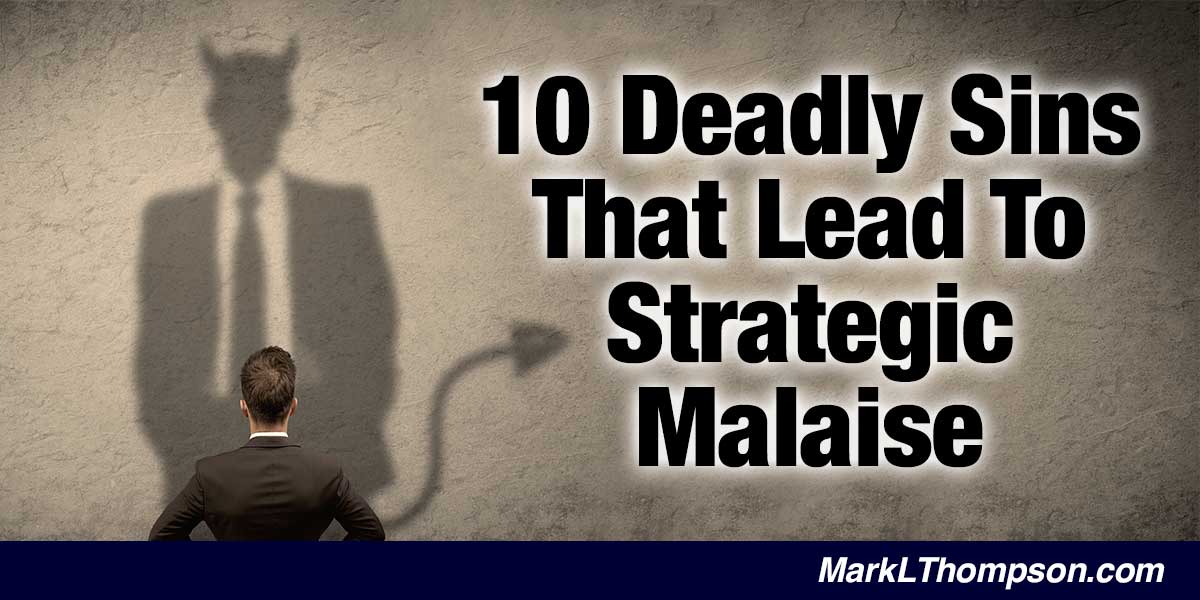There are 10 deadly sins that an organization can commit that will inevitably lead to these two conditions that might well spell corporate extinction. Some say it is easy to develop a strategy and that it is the implementation that is difficult. My own experience is that exact opposite is true.
If a CEO thinks that he or she has a solid corporate strategy, and yet it is not being implemented only one of two things are happening:
- The management team doesn’t know or understand the strategy.
- If management knows and understands but is still not implementing it’s because members of the management team don’t agree with the strategy and may, in fact, be trying to sabotage it.
#1 Strategy by Osmosis
In too many organizations, the strategy of the company is implicit and resides solely in the head of the chief executive. Most CEOs have some kind of strategy. However, they often have great difficulty articulating it to the people around them in a form that allows these people to make consistent and intelligent decisions on behalf of the company.
The solution we have found the most effective is to develop a consensus about the strategy with a cross functional group of executives. A senior executive at a Fortune 500 company told us, “the reason I have difficulty implementing my CEO’s strategy is I don’t know what it is!”
#2 Strategies in Isolation
Many CEOs have a strategy, but their key people were not involved in the process of developing it and therefore they have no ownership. In such cases subordinates usually do not understand the rationale behind the strategy and will spend more time questioning it, or trying to figure out where they fit, than in implementing it.
Involvement by senior managers in the basic strategic decisions is the most effective way to create a strategy that not only looks good on paper but also actually gets implemented. As one of my clients put it, “I think that too often, strategies are made in a vacuum.”
# 3 Outsourcing the Strategy to an Outside Consultant
The “kiss of death” for any strategy, even a good one, is to have an outside consultant develop it. Almost any strategy will work to some degree unless it is completely invalidated by negative environmental factors.
Experience has shown, however, that no strategy will work as well as it should if a couple or few members of senior management are not committed to that strategy. The strategy must be of the people, by the people, through the people. It must be owned by the people who will later have to live with it.
#4 Operational managers are not trained as strategic thinkers
Because most people spend their entire lives within an organization dealing exclusively with operational issues, they are not good strategic thinkers.
We have found with few exceptions that the CEO or the general manager is the only ones who sees the “big picture” and views the business and its environment in strategic terms. Most executives only have the fuzziest notion of the functions of strategy formulation. This is why a process that guides the management team through these issues is essential.
#5 Planning Paralysis
Participation in a clearly strategic process is an eye-opener for most managers. Most have never participated in a strategy session, or if they have they have dealt with operational issues.
Most management should understand that planning encompasses two distinct functions: long range operational planning and strategy formulation. The process that is needed to determine the future direction of the organization is not strategic planning but rather strategic thinking. Strategic thinking is a process that lets management sit together and think through the qualitative aspects of the business and its environment.
#6 Meaningless Mission Statements
In the last few years I have noticed a substantial increase in the number of corporations that have attempted to construct mission or vision statements that try to articulate the business’s raison d’ etre.
Unfortunately, these efforts are usually fruitless because they lack structured process that could help them in their discussions. As a result they produce mission statements that are so “motherhood” in that everyone can agree with them, that they are useless as guides to help people make intelligent decisions on behalf of the organization.
#7 No Crisis No Strategy
Good times are another obstacle that impedes good strategic thinking. When the numbers are good and the charts are all pointing upward, who needs to think about where they are going? When it is not raining, why fix the roof?
The need to think about strategy usually surfaces in a crisis. One of our clients said “my success in business has largely been the result of my ability to focus on long term goals and ignore short term distractions.” Taking the long view does not require brilliance but does require dedication.
#8 The Critical Issues are not Defined
One aspect of corporate strategy is formulation. Another is thinking through implications. What are the implications of your strategy? Most organizations do not think through these implications. As a result they end up reacting to events as they are encounter them and many start to lose faith in the strategy.
A good strategic process should help management identify, anticipate, and effectively manage the strategy’s implications on the company’s products, markets, customers, organizational structure, systems, processes, personnel, and culture.
#9 Understanding the Difference Between Process and Content
In every strategy session there are two dynamics at work, namely process and content.
Content is information or knowledge that is company or industry specific. Most people climb the ladder in their organization because they are content experts. It is necessary for them to get though the content-laden operational issues.
At the strategic level which is above the silos content expertise is not sufficient. Strategy is process– based not content based. In fact having too much content expertise can get in the way. Operational management requires the skill of analysis where strategic management requires the skill of synthesis.
#10 Using a Content Consultant
A CEO who elects to seek outside assistance to help decide the future direction of the company is faced with having to choose between two very different types of consultants. The objective of content consultants is to formulate a strategy for you because your people are not as knowledgeable as their “experts”.
In other words they do it for you, or to you. Their job is to sell content. Unfortunately they sell the same content to you and to all clients in the industry. The result at best is a me-too strategy. A better service to a CEO and management team is to bring them a critical thinking template and guide them through that process. One of our clients stated the greatest value of strategic thinking is that it extracts the thinking and ideas from the executives’ heads, rather that imposing the consultants thinking.
Biography
As Partner with Decision Processes International for the last twenty years Mark Thompson is involved with all facets of their technologies such as Strategic Thinking, Competitive Analysis, Strategic Product Innovation, Problem Solving and Decision Making.
Mark specializes in developing and managing corporate strategies. He directs the development of innovative business strategies by combining broad experience, insight, creativity, and analytic methods. Mr. Thompson has led over 150 strategy projects in numerous industries such as utility, telecommunications, manufacturing, financial, oil drilling, construction, and the defense industry.
Some of his clients included Caterpillar, Acuity Insurance, Lyman Lumber Company, Raytheon E- Systems, United Medical Resources, Portland General Electric, Henkel, Ball Corporation, Ball Aerospace & Technologies, Olan Mills, Inc, Shiloh Industries, Molson Coors, TD Williamson Inc, Sun Hydraulics Corporation, Donaldson Company, and Rand Merchant Bank in South Africa, Sun Hydraulics Corporation, Donaldson Company, and Rand Merchant Bank in South Africa Community Bank of Tomah, Whirlpool Financial Services.
If you are frustrated by any of the 10 sins discussed above find out how to regain control of your company’s strategy. Create your own long term strategy to achieve competitive supremacy in your marketplace now! I would like to have a conversation with you about your current challenges to determine if there is a fit between those challenges and what I do well. Please contact me, [email protected] or 941-373- 6520. Don’t wait until your competitors have you in their sights.
Corporate Strategy” src=”https://marklthompson.com/wp-content/uploads/10-deadly-sins-corporate-strategy-tall.jpg” width=”600″ height=”1200″ />

